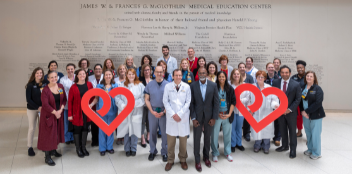Advancing the understanding of aging hearts
Recent advances in clinical treatment have dramatically improved outcomes for adult patients suffering an acute myocardial infarction, or heart attack. However, the outcome for elderly patients remains disappointing.
 Dr Qun Chen
Dr Qun Chen
Ongoing research by Dr. Qun Chen, associate professor in the Division of Cardiology, and Dr. Edward Lesnefsky, professor in the Division of Cardiology, focusing on aging hearts may lead to new ways of addressing cardiac injury in the aging population. Elderly patients have a higher mortality rate during heart attack compared to young and adult patients, even with the current highly successful use of emergency coronary intervention with stents to open the blocked artery during a heart attack.
In their study, the researchers hypothesized that pre-existing and age-related mitochondrial defects are a key factor increasing susceptibility to cardiac injury in aged hearts. Mitochondria are organelles found in the cells of every complex organism and produce about 90% of the chemical energy that cells need to survive.
“We propose that the restoration of mitochondrial function in aged hearts in the baseline state is critical to improve outcomes in the aged heart,” said Chen, principal investigator. Specifically, the researchers are paying close attention to the relationship between mitochondrial function and the endoplasmic reticulum (ER), a cellular organelle responsible for protein and lipid synthesis. “Our ongoing studies support the idea that ER stress is a key mechanism inducing mitochondrial dysfunction,” Chen said. “Therefore, we anticipate that mitochondrial function will be improved in aged hearts by modulating the ER stress present in the baseline condition.”
Preclinical studies in mice revealed ER stress progressively increased with age. Feeding the elderly mice a fatty acid compound called 4-phenylbutyrate for two weeks markedly improved the ER stress and improved mitochondrial function. These results indicate that ER stress precedes and contributes to the mitochondrial dysfunction during aging.
Age-induced mitochondrial dysfunction in the heart is at least partly reversible. Interventions to decrease ER stress and improve mitochondrial function in aged hearts could include a pharmacologic approach, which could use drugs already available for other uses.
Understanding the link between ER stress and mitochondrial dysfunction in aged hearts not only advances our understanding of the mechanisms of the mitochondrial defect, but also provides insights to develop treatment strategies to reduce cardiac injury, Chen said. “We believe the results obtained from our study can have rapid translational relevance to improve the outcome of elderly patients during heart attacks.”
The results from this study will inform future research.
Back to Autumn-2020

